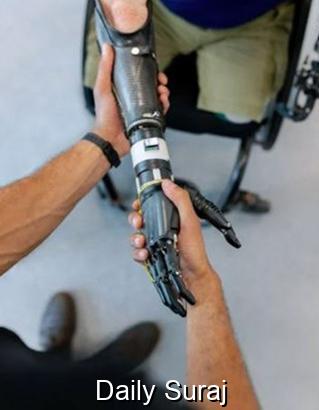Researchers Invent Synthetic Skin That Feels Like the Real Thing
- International
- 17 Jun,2025

Washington DC [US] : Researchers have created a revolutionary robotic skin that brings machines closer to human-like touch.Made from a flexible, low-cost gel material, this skin transforms the entire surface of a robotic hand into a sensitive, intelligent sensor.
Unlike traditional robotic skins that rely on a patchwork of different sensors, this material can detect pressure, temperature, pain, and even distinguish multiple contact points all at once.
The researchers, from the University of Cambridge and University College London (UCL), developed the flexible, conductive skin, which is easy to fabricate and can be melted down and formed into a wide range of complex shapes.
The technology senses and processes a range of physical inputs, allowing robots to interact with the physical world in a more meaningful way.
Unlike other solutions for robotic touch, which typically work via sensors embedded in small areas and require different sensors to detect different types of touch, the entirety of the electronic skin developed by the Cambridge and UCL researchers is a sensor, bringing it closer to our own sensor system: our skin.
Although the robotic skin is not as sensitive as human skin, it can detect signals from over 860,000 tiny pathways in the material, enabling it to recognise different types of touch and pressure - like the tap of a finger, a hot or cold surface, damage caused by cutting or stabbing, or multiple points being touched at once - in a single material.
Researchers used a combination of physical tests and machine learning techniques to help the robotic skin 'learn' which of these pathways matter most, so it can sense different types of contact more efficiently.
In addition to potential future applications for humanoid robots or human prosthetics where a sense of touch is vital, the researchers say the robotic skin could be useful in industries as varied as the automotive sector or disaster relief.
Electronic skins work by converting physical information - like pressure or temperature - into electronic signals. In most cases, different types of sensors are needed for different types of touch - one type of sensor to detect pressure, another for temperature, and so on - which are then embedded into soft, flexible materials.However, the signals from these different sensors can interfere with each other, and the materials are easily damaged.
"Having different sensors for different types of touch leads to materials that are complex to make," said lead author Dr David Hardman from Cambridge's Department of Engineering.
"We wanted to develop a solution that can detect multiple types of touch at once, but in a single material," added Hardman.
"At the same time, we need something that's cheap and durable, so that it's suitable for widespread use," said co-author Dr Thomas George Thuruthel from UCL.
In future, the researchers are hoping to improve the durability of the electronic skin, and to carry out further tests on real-world robotic tasks.
#RoboticSkin #ArtificialIntelligence #HumanMachineInteraction #TechInnovation #SmartProsthetics #NextGenRobots #BioinspiredDesign #PainSensingRobots #FutureOfRobotics #WearableTech
Posted By:
 Daily Suraj Bureau
Daily Suraj Bureau

Leave a Reply